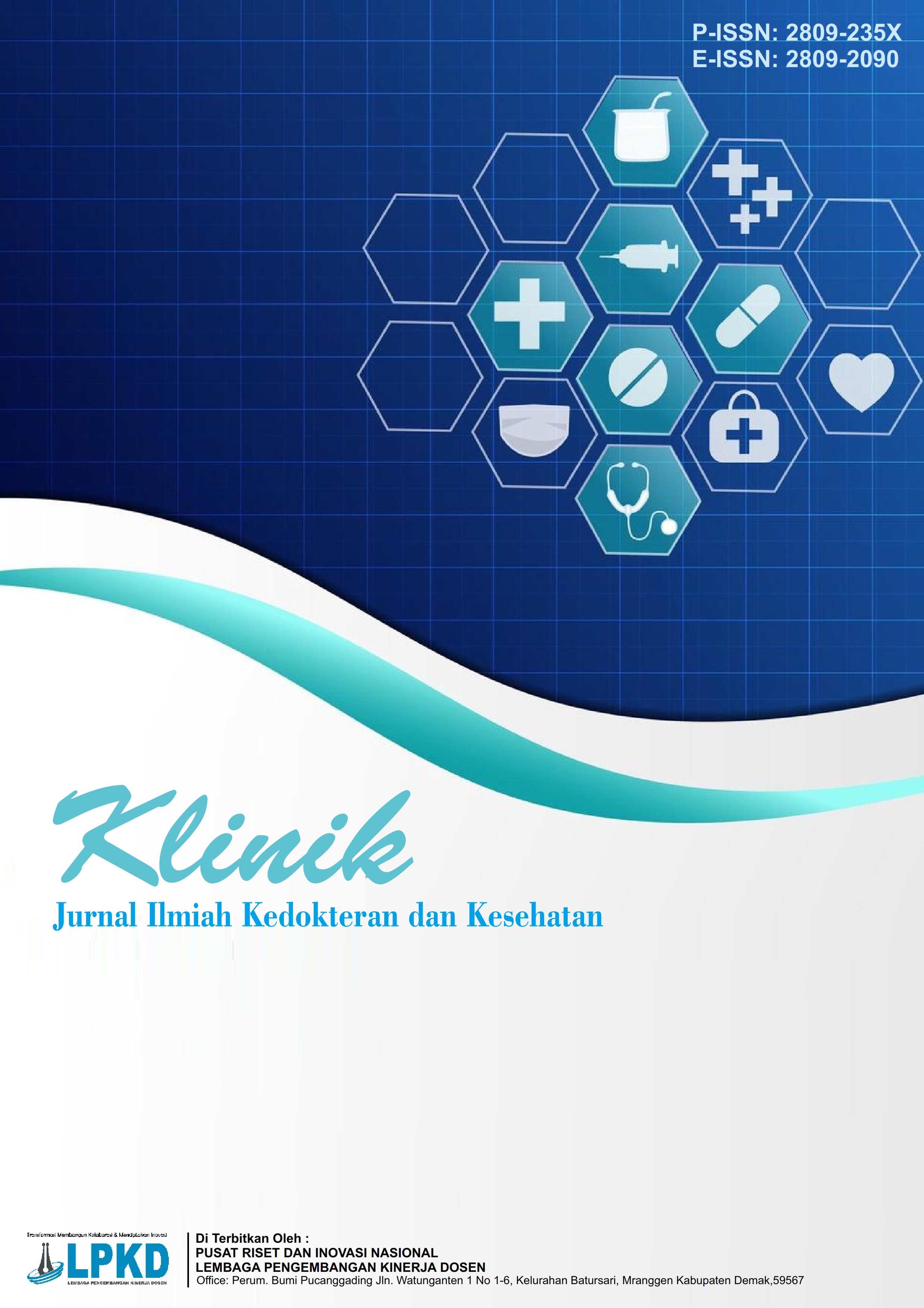Literature Review: Potensi Monascus Purpureus sebagai Agen Antikolesterol Alami
DOI:
https://doi.org/10.55606/klinik.v5i1.5617Keywords:
Anticholesterol, Lipid Metabolism, Monacolin K, Monascus Purpureus, Red Yeast RiceAbstract
Monascus purpureus, also known as red yeast rice, is a red mold widely used in traditional Asian food fermentation, particularly in Indonesia and China. One of its main bioactive compounds is monacolin K, a substance structurally identical to lovastatin, a well-known cholesterol-lowering statin drug. Monacolin K works by inhibiting the HMG-CoA reductase enzyme, a key enzyme in the biosynthesis of cholesterol in the liver. Various modern studies have demonstrated that Monascus purpureus consumption can significantly reduce total cholesterol, low-density lipoprotein (LDL), and triglyceride levels, while increasing high-density lipoprotein (HDL) levels, with relatively minimal side effects compared to synthetic statins. In addition, the natural pigments produced by Monascus purpureus, such as monascin and ankaflavin, exhibit strong antioxidant and anti-inflammatory activities that help protect vascular endothelial cells from oxidative stress and inflammation—two major factors contributing to atherosclerosis. The combination of M. purpureus extracts with probiotics or other natural ingredients, such as garlic or fermented soy products, has also been shown to produce synergistic effects in improving lipid metabolism and promoting cardiovascular health. With its potent bioactive components and high safety profile, Monascus purpureus holds great potential to be developed as a natural anticholesterol agent for the prevention and management of dyslipidemia in a sustainable and effective manner.
References
Amin, S., Ma’rifatillah, P. N. N., Permatasari, I., & Maryam, S. (2025). Eksplorasi kimia medisinal untuk terapi kolesterol tinggi: Analisis struktur-aktivitas dan target molekuler obat. Jurnal Riset Rumpun Ilmu Kesehatan, 4(1), 109–121. https://doi.org/10.55606/jurrikes.v4i1.4392
Amin, S., Nurassyifa, R. P. R., Awalia, N. N., & Kusumadewi, F. B. (2025). Literatur review: Peran kimia medisinal dalam penanganan Alzheimer dan penyakit neurodegeneratif. Indonesian Research Journal on Education, 5(3), 66–71.*
Cao, N. T., Nguyen, N. A., Park, C. M., Cha, G. S., Park, K. D., & Yun, C. H. (2021). A novel statin compound from monacolin J produced using CYP102A1-catalyzed regioselective C-hydroxylation. Pharmaceuticals, 14(10), 981. https://doi.org/10.3390/ph14100981
Chen, X., Wang, J., & Li, Z. (2020). The effect of fermentation conditions on the production of monacolin K and the reduction of sitrinin by genetically engineered Monascus purpureus. Food Control, 113, 107168. https://doi.org/10.1016/j.foodcont.2020.107168
Cicero, A. F. G., Fogacci, F., & Banach, M. (2019). Red yeast rice for hypercholesterolemia. Methodist DeBakey Cardiovascular Journal, 15(3), 192–199. https://doi.org/10.14797/mdcj-15-3-192
English, K. (2025). Red yeast rice with monacolin K for the improvement of hyperlipidemia: A narrative review. World Journal of Clinical Cases, 13(27), 1–14. https://doi.org/10.12998/wjcc.v13.i27.105415
Gojkovic, T., Vladimirov, S., Kotur-Stevuljevic, J., Bogavac-Stanojevic, N., Zeljkovic, A., Vekic, J., Antonic, T., & Spasojevic-Kalimanovska, V. (2021). Effects of monacolin K-containing nutraceutical on cholesterol homeostasis re-establishment and CVD risk reduction in hypercholesterolemic subjects. European Review for Medical and Pharmacological Sciences, 25(16), 5261–5267. https://doi.org/10.26355/eurrev_202108_26546
Guerrero-Bonmatty, R., Gil-Fernández, G., Rodríguez-Velasco, F. J., & Espadaler-Mazo, J. (2021). A combination of Lactoplantibacillus plantarum strains CECT7527, CECT7528 and CECT7529 plus monacolin K reduces blood cholesterol: Results from a randomized, double-blind, placebo-controlled study. Nutrients, 13(4), 1206. https://doi.org/10.3390/nu13041206
Hu, P., Zhang, L., Hu, H., Wang, D., Chen, J., Xiao, J., Wu, H., Qi, L., Qin, K., Zuo, X., & Li, J. (2025). Red yeast rice extract improves lipid metabolism by modulating gut microbiota in high-fat diet mice. Frontiers in Pharmacology, 16, 1–15. https://doi.org/10.3389/fphar.2025.1608582
Liasi, E., Kantilafti, M., Hadjimbei, E., & Chrysostomou, S. (2024). Monacolin K supplementation in patients with hypercholesterolemia: A systematic review of clinical trials. Semergen, 50(4), 102156. https://doi.org/10.1016/j.semerg.2023.102156
Lu, K. Y., Chen, S. H., Lin, Y. S., Wu, H. P., & Chao, P. M. (2020). An antidiabetic nutraceutical combination of red yeast rice (Monascus purpureus), bitter gourd (Momordica charantia), and chromium alleviates dedifferentiation of pancreatic β cells in db/db mice. Food Science and Nutrition, 8(12), 6718–6726. https://doi.org/10.1002/fsn3.1966
Mahfudh, N., Mantali, M. F., & Sulistyani, N. (2022). The antihyperlipidemic effect of purple sweet potato leaf extract (Ipomoea batatas L.) and red yeast rice combination on hypercholesterol rats. Indonesian Journal of Pharmacy, 33(1), 93–99. https://doi.org/10.22146/ijp.2115
Mohankumari, H. P., Naidu, K. A., Narasimhamurthy, K., & Vijayalakshmi, G. (2021). Bioactive pigments of Monascus purpureus attributed to antioxidant, HMG-CoA reductase inhibition and anti-atherogenic functions. Frontiers in Sustainable Food Systems, 5, 590427. https://doi.org/10.3389/fsufs.2021.590427
Murray, C. J. L. (2020). Global burden of 87 risk factors in 204 countries and territories, 1990–2019: A systematic analysis for the Global Burden of Disease Study 2019. The Lancet, 396(10258), 1223–1249. https://doi.org/10.1016/S0140-6736(20)30752-2
Pahlani, E., Tantriska, & Aldi. (2024). Studi in-vitro: Efek antikolesterol dari ekstrak angkak. Jurnal Ilmiah JKA (Jurnal Kesehatan Aeromedika), 10(2), 78–85. https://doi.org/10.58550/jka.v10i2.270
Shaleha, R. R., Yuliana, A., Amin, S., Levita, J., & Sumiwi, S. A. (2025). Monascus purpureus red yeast rice: A review of the in vitro and in vivo pharmacological activities, studies in humans, and case reports. Clinical Pharmacology: Advances and Applications, 17, 269–289. https://doi.org/10.2147/CPAA.S542721
Singgih, M., Permana, B., Maulidya, S. A. I., & Yuliana, A. (2019). Studi in silico metabolit sekunder kapang Monascus sp. sebagai kandidat obat antikolesterol dan antikanker. Alchemy: Jurnal Penelitian Kimia, 15(1), 104–123. https://doi.org/10.20961/alchemy.15.1.25294.104-123
Yuan, X., Gao, S., Tan, Y., Cao, J., Yang, S., & Zheng, B. (2023). Production of red yeast rice rich in monacolin K by variable temperature solid fermentation of Monascus purpureus. RSC Advances, 13(39), 27303–27308. https://doi.org/10.1039/D3RA04374F
Yuliana, A., Khusnul, Z., Zannah, S. U., Rahmiyani, I., & Amin, S. (2020). Fermentation and determination of anti-cholesterol monacolin K from different Monascus purpureus isolates. Advances in Health Sciences Research, 26, 225–227. https://doi.org/10.2991/ahsr.k.200523.055
Zou, J., Yan, C., & Wan, J. B. (2022). Red yeast rice ameliorates non-alcoholic fatty liver disease through inhibiting lipid synthesis and NF-κB/NLRP3 inflammasome-mediated hepatic inflammation in mice. Chinese Medicine, 17(1), 1–15. https://doi.org/10.1186/s13020-022-00573-z
Downloads
Published
How to Cite
Issue
Section
License
Copyright (c) 2025 Jurnal Ilmiah Kedokteran dan Kesehatan

This work is licensed under a Creative Commons Attribution-ShareAlike 4.0 International License.








